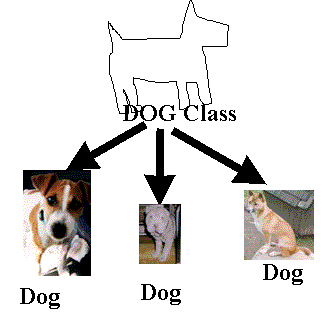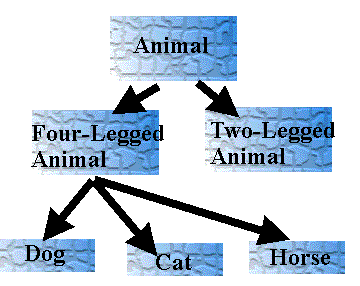Overview of OOP
Objectives:
- modular programming.
- reusable code/modules.
- inheritance.
- can define interfaces
Class = a template representing a self-contained element of a computer program (i.e. a module) that represents related information and has the cability to accomplish specific tasks through the invokation of methods.
Object = a particular instance of a class.
Instance = same thing as Object.
An OO Program = A set of classes, pluseobjects created from those classes and used as needed.
class library = group of classes that you can use in your own program. In Java, we also call this a package (a group of related classes).
- Packages in java are called java.*
- by default, your java classes have access only to the pacakage java.lang You must refer to other classes explicitly ( e.g. java.awt.Color) or import the package and then just use the classname.
Example

Dog Class and several Dog objects/instances
Inheritance
- a mechanism that enables one class to inherit all the behaviors and attributes of another class.
subclass = a class that inherits from another class.
superclass = a class that is its inheritance to another class. Example

Hierarchy of Animal Classes.
Note: Subclasses can override methods they have inherited if they want to change the corresponding behavior. For example, the method to calculate the Expected Lifespan for each Class of Dog, Cat, and Horse may be different from thier superclass Four-Legged Animal.
Interfaces
- is a collection of methods that indicate a class has some behavior in addition to what it inherits from its superclasses
- It is the way that a set of method names, without definitions. By this I mean the method's interface is presented but not implemented. This will allow similar behavior to be duplicated acrros different parts of the class hierarchy which is achievable in C++ through multiple inheritance which Java does not allow.
- Can not declare an object of this class....must create a new class that extends this and implements all of the unimplemented methods.